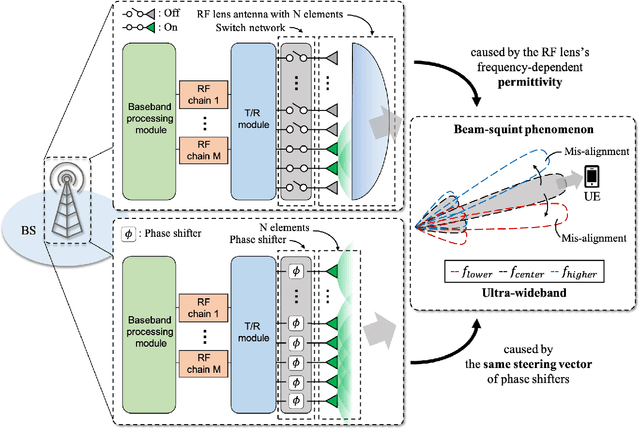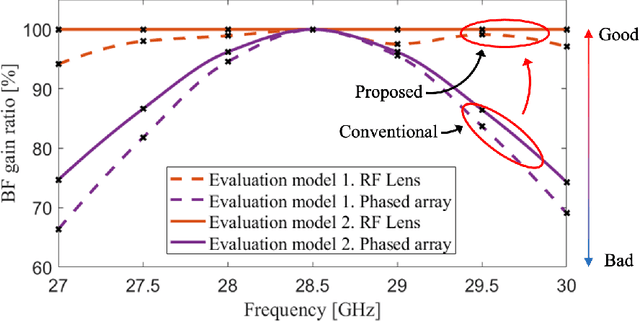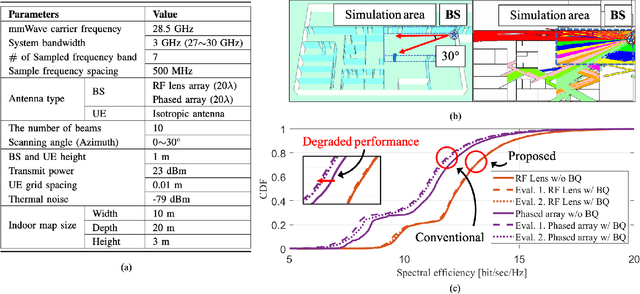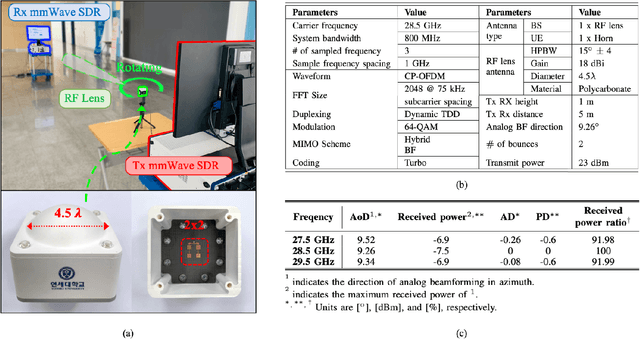Dong Ku Kim
AoA-based Position and Orientation Estimation Using Lens MIMO in Cooperative Vehicle-to-Vehicle Systems
Jun 29, 2023Abstract:Positioning accuracy is a critical requirement for vehicle-to-everything (V2X) use cases. Therefore, this paper derives the theoretical limits of estimation for the position and orientation of vehicles in a cooperative vehicle-to-vehicle (V2V) scenario, using a lens-based multiple-input multiple-output (lens-MIMO) system. Following this, we analyze the Cram$\acute{\text{e}}$r-Rao lower bounds (CRLBs) of the position and orientation estimation and explore a received signal model of a lens-MIMO for the particular angle of arrival (AoA) estimation with a V2V geometric model. Further, we propose a lower complexity AoA estimation technique exploiting the unique characteristics of the lens-MIMO for a single target vehicle; as a result, its estimation scheme is effectively extended by the successive interference cancellation (SIC) method for multiple target vehicles. Given these AoAs, we investigate the lens-MIMO estimation capability for the positions and orientations of vehicles. Subsequently, we prove that the lens-MIMO outperforms a conventional uniform linear array (ULA) in a certain configuration of a lens's structure. Finally, we confirm that the proposed localization algorithm is superior to ULA's CRLB as the resolution of the lens increases in spite of the lower complexity.
Sparse RF Lens Antenna Array Design for AoA Estimation in Wideband Systems: Placement Optimization and Performance Analysis
Jun 29, 2023



Abstract:In this paper, we propose a novel architecture for a lens antenna array (LAA) designed to work with a small number of antennas and enable angle-of-arrival (AoA) estimation for advanced 5G vehicle-to-everything (V2X) use cases that demand wider bandwidths and higher data rates. We derive a received signal in terms of optical analysis to consider the variability of the focal region for different carrier frequencies in a wideband multi-carrier system. By taking full advantage of the beam squint effect for multiple pilot signals with different frequencies, we propose a novel reconfiguration of antenna array (RAA) for the sparse LAA and a max-energy antenna selection (MS) algorithm for the AoA estimation. In addition, this paper presents an analysis of the received power at the single antenna with the maximum energy and compares it to simulation results. In contrast to previous studies on LAA that assumed a large number of antennas, which can require high complexity and hardware costs, the proposed RAA with MS estimation algorithm is shown meets the requirements of 5G V2X in a vehicular environment while utilizing limited RF hardware and has low complexity.
Beam Squint in Ultra-wideband mmWave Systems: RF Lens Array vs. Phase-Shifter-Based Array
Dec 08, 2021



Abstract:In this article, we discuss the potential of radio frequency (RF) lens for ultra-wideband millimeter-wave (mmWave) systems. In terms of the beam squint, we compare the proposed RF lens antenna with the phase shifter-based array for hybrid beamforming. To reduce the complexities for fully digital beamforming, researchers have come up with RF lens-based hybrid beamforming. The use of mmWave systems, however, causes an increase in bandwidth, which gives rise to the beam squint phenomenon. We first find the causative factors for beam squint in the dielectric RF lens antenna. Based on the beamforming gain at each frequency, we verify that, in a specific situation, RF lens can be free of the beam squint effect. We use 3D electromagnetic analysis software to numerically interpret the beam squint of each antenna type. Based on the results, we present the degraded spectral efficiency by system-level simulations with 3D indoor ray tracing. Finally, to verify our analysis, we fabricate an actual RF lens antenna and demonstrate the real performance using a mmWave, NI PXIe, software-defined radio system.
Secure Transmission for Hierarchical Information Accessibility in Downlink MU-MIMO
Sep 16, 2021



Abstract:Physical layer security is a useful tool to prevent confidential information from wiretapping. In this paper, we consider a generalized model of conventional physical layer security, referred to as hierarchical information accessibility (HIA). A main feature of the HIA model is that a network has a hierarchy in information accessibility, wherein decoding feasibility is determined by a priority of users. Under this HIA model, we formulate a sum secrecy rate maximization problem with regard to precoding vectors. This problem is challenging since multiple non-smooth functions are involved into the secrecy rate to fulfill the HIA conditions and also the problem is non-convex. To address the challenges, we approximate the minimum function by using the LogSumExp technique, thereafter obtain the first-order optimality condition. One key observation is that the derived condition is cast as a functional eigenvalue problem, where the eigenvalue is equivalent to the approximated objective function of the formulated problem. Accordingly, we show that finding a principal eigenvector is equivalent to finding a local optimal solution. To this end, we develop a novel method called generalized power iteration for HIA (GPI-HIA). Simulations demonstrate that the GPI-HIA significantly outperforms other baseline methods in terms of the secrecy rate.
 Add to Chrome
Add to Chrome Add to Firefox
Add to Firefox Add to Edge
Add to Edge